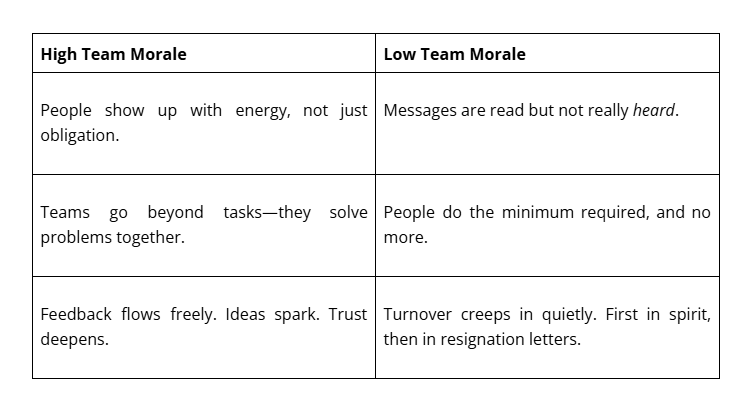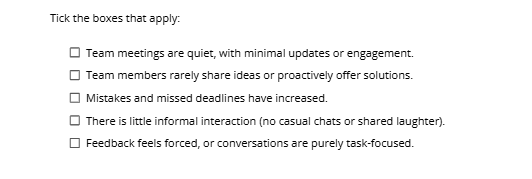
Abayomi Tunde Sowemimo
Abayomi Tunde Sowemimo is a Product Manager and Agile Advocate focused on building impactful digital solutions. He has led cross-functional teams across multiple sectors and delivers products that solve real problems. He is also the author of “Arise, O Product Managers!”
Article by Gigson Expert
Three years ago, I worked with a very lively and wonderful colleague. Full of life, the type that creates a buzz around the room, the happiness he exudes was always contagious. Our company had just moved from an on-site mode of work to remote work for all staff. The one person who used to bring snacks to the office, organise birthday cards, and remind people to take their lunch breaks, stopped interacting with colleagues. Pause for a moment, it's logical to conclude that the shift to remote work must have been the causative factor.
Irrespective, he was still efficient, productive, but invisible. He always delivered and met deadlines. But what no one saw, what no spreadsheet or scrum board could show, was that he hadn’t spoken to another human outside of work in days. I thought to myself, without hallway conversations or spontaneous high-fives, the humanity of teamwork is gradually fading.
It wasn’t just him! Across continents and time zones, teams that once thrived on laughter across desks and impromptu coffee chats were now operating in silence. Collaboration tools hummed with activity, yet something essential was missing: connection! This isn’t just a feeling as Buffer's remote work survey shows that 23% of fully remote workers list loneliness as a top struggle.
Team Morale Isn’t Automatic
Team morale isn’t automatic, but what turns a group of people into a real team. In remote or hybrid work, leaders must nurture that energy through connection and intentional culture-building.
As someone who used to believe ‘all work and no play makes Yomi a bright boy,’ I never realized how much a lack of intentional culture-building in remote teams could quietly create disconnection.
Why Morale Matters More Than Ever
In the pre-COVID era, you could walk into an office and feel morale.
It was in the buzz of morning greetings, the raised eyebrows across open-plan desks, the laughter spilling out of meeting rooms. If something was off, you knew. Like a tight-lipped silence during lunch, an awkward energy in the hallway. Managers could sense it, team leads could respond to it, and colleagues could offer support—all in real time.
But now? A tired voice on Zoom is easy to mute. A frown is hidden behind a frozen video tile. People drop off calls before you can say, “How are you, really?”
Safe to say, in remote and hybrid environments, low morale has become easier to miss and harder to fix and yet the stakes are higher than ever.
Research shows from Gallup's State of the Global Workplace 2024 that low employee engagement costs the global economy about US$8.9 trillion (9% of global GDP) and is directly linked to productivity and retention challenges.

Quick Diagnostic Checklist: Is Your Team Showing Signs of Low Morale?

If you’ve checked 3 or more, your team might be silently struggling.
The Silent Signals of a Team with a Struggling Morale
In remote teams, morale doesn’t drop with a bang; it fades quietly. People still attend meetings, hit deadlines, and smile on calls, but behind the screen, they’re disconnecting. Watch for these subtle signals:
- Silent Meetings: Check-ins feel like a chore, and updates are minimal.
- Lack of Initiative: Once-proactive teammates stop offering ideas.
- Increased Mistakes or Missed Deadlines: Often a sign of burnout or mental fatigue, not incompetence.
- Minimal Collaboration: Cross-functional chats slow down, an, d “just tell me what to do” becomes the norm, turning teams into task factories rather than creative ecosystems.
What Great Leaders Do Differently in Remote and Hybrid Teams
I once asked my former team lead how he handled the sudden shift to remote work. He admitted he didn’t know how to code morale into a Slack message or spark trust over pixelated video calls. But he learned one key lesson:
If people are going to do their best work from behind screens, they need more than deadlines.
Microsoft’s Work Trend Index Microsoft Worklab confirms this: while employees value flexibility, managers rank “maintaining team connection & culture” among their biggest hybrid challenges.
Great leaders in remote and hybrid teams don’t lead harder; they lead smarter and softer. They trade control for clarity, supervision for support, and silence for structured check-ins.
Here’s how:
- Always Ask “How Are You?” and Mean It: It’s not a throwaway line but a genuine question that opens the door to honest conversations.
- Celebrate Effort, Not Just Wins: Remote praise doesn’t happen by accident—if you don’t say it, it’s invisible.
- Encourage Voice Equity: Hybrid meetings can silence remote voices unless leaders intentionally create space for everyone.
- Make Emotional Check-ins a Habit: Use mood trackers, pulse surveys, or rotating one-on-ones to keep a finger on the team’s well-being.
- Share Context, Not Just Commands: Over-communicate the why behind tasks to foster alignment and trust.
- Model Vulnerability: Admitting uncertainty or sharing a personal challenge encourages others to open up, too.
Designing a Culture of Connection
Culture isn’t built through virtual game nights or monthly town halls. It’s woven into daily interactions, how feedback flows, how safety is felt, and how teams support one another when the camera is off.
I remember when my team’s energy was fading, even though we were shipping features and hitting deadlines. It all felt robotic. One day, I suggested we plan a casual outing—a sip-and-paint night. The excitement was instant. We laughed, painted terribly, and shared stories over dinner—no laptops, no slides, just people reconnecting.
That simple gathering reignited empathy during troubleshooting sessions and made feedback more constructive. It reminded us why we chose to work together. That’s culture: not the work you do, but the way you hold each other up while doing it.
How to Keep Morale Alive:
- Create Intentional Rituals: A Monday kickoff where everyone shares one personal and one professional goal. A Friday wrap-up celebrating both wins and lessons.
- Build Informal Spaces: “Watercooler” Slack channels, virtual coffee chats, or buddy systems humanize digital workplaces.
- Make Psychological Safety Visible: If mistakes are punished, people stop speaking up. Safety is the heartbeat of innovation.
- Co-Create Team Values: Culture is built, not imposed. Design communication and collaboration norms together so people protect what they help create.
- Invest in Emotional Intelligence: Tools connect devices, but empathy connects people. Train leaders and teams to listen deeply and respond with care.
Conclusion:
Remote and hybrid work are here to stay, but isolation doesn’t have to be. Distance doesn’t mean disconnection, and productivity shouldn’t cost us our humanity. Boosting morale today is no longer just a leadership skill, it’s a human commitment: to show up, reach out, and create a culture where people feel not just employed but truly alive.
Key Takeaways:
- Check-in with care: Ask “How are you?” and mean it.
- Celebrate effort: Acknowledge contributions, not just outcomes.
- Create informal spaces: Encourage non-work conversations.
- Model vulnerability: Show it’s okay not to have all the answers.
- Design rituals: Regular kickoffs, wrap-ups, or pulse surveys build connection.
Toolbox: Resources for Tracking and Boosting Morale
- Officevibe: Great for quick team mood check-ins and anonymous feedback.
- 15five: Helps with continuous performance conversations and employee recognition.
- CultureAmp: Focuses on engagement surveys, analytics, and action planning.
- TinyPulse: Allows for lightweight pulse surveys and real-time employee feedback.




